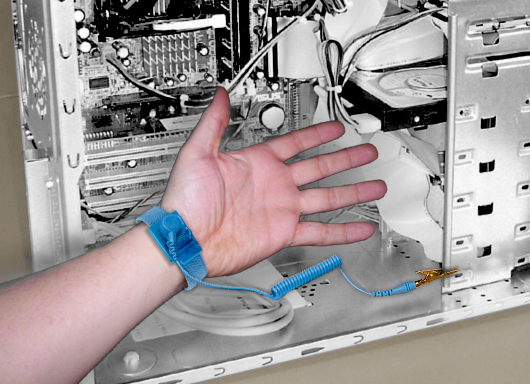 --> (Word) --> (Word) |  --> (PDF) --> (PDF) |  --> (Epub) --> (Epub) |  --> (Text) --> (Text) |
 --> (XML) --> (XML) |  --> (OpenOffice) --> (OpenOffice) |  --> (XPS) --> (XPS) | |
Understanding ESD
What is ESD?
The human body can build up static charges of up to 25000 volts. These can discharge into a body or device that has lower charge. This surge of electricity can damage electronic devices.
Why is a 25kV discharge not fatal?
The 25kV associated with video monitors can be deadly; whereas the 10 25kV associated with ESD is not harmful to humans. The reason is the difference in current-delivering capabilities created by the voltage:
A video monitor gets its power from a constant power supply. Current is continually supplied, pushed at a constant voltage.
In a static discharge, a build-up of electrical charge creates the high voltage. When the discharge occurs, the charges move (current flows) through the conductor (a human or a PC circuit board). However, as the built-up charges dissipate the pushing voltage drops and the current also drops. Within microseconds the current will cease to be at dangerous levels.
A mains powered device (such as a 230V ac power supply) is much more dangerous than a 25kV static discharge.
Common causes of ESD
The most common causes of ESD are:
- Moving people
- Moving machines
- Improper grounding
- Poor connections
- Low humidity (hot and dry conditions)
When people move, their clothes rub together and can produce large amounts of electrostatic charge on their bodies. Walking across carpeting can create charges in excess of 1,000 volts. Motors in electrical devices, such as vacuum cleaners and refrigerators, also generate high levels of ESD. Note, however, that compressed air does not usually create ESD problems.
ESD is most likely to occur during periods of low humidity. ESD generally does not occur when the humidity is above 50%. Normal air-conditioning removes moisture from the atmosphere and can increase the potential for ESD.
Risk to circuitry
ESD poses a risk to some electronic circuitry, where even a micro-amp current discharge can damage miniature transistors.
Metal oxide semiconductor (MOS) devices (used in CMOS digital circuitry throughout a PC) are sensitive to voltage spikes and ESD. Simply touching a CMOS device could destroy it.
Note: The "CMOS memory" on a motherboard was named at a time when that IC was the only one made from CMOS circuitry; nowadays, most ICs inside a PC are built using CMOS technology.
Precautions
Equipotentials
To avoid static discharge the technician needs to be at an equal electrical potential to the device being worked on. This will mean that there is no voltage difference and therefore no static charge can flow as a current.
Anti-static wrist strap
Technicians normally use a grounding strap, placed around the wrist or ankle. This may be connected to the chassis of the PC or to a large area of metal on a circuit board, usually the ground plane.

Antistatic wrist or ankle straps should NEVER be worn while working on higher voltage components, such as monitors and power-supply units.
Some technicians wrap a copper wire around their wrist to use as a wrist strap. This is not safe because the resistive feature of a true wrist strap is missing.
Antistatic work area
This principle can be extended to an entire work area.
It is common to place a metal-impregnated mat (an "anti-static mat") on the work surface and connect this to 0V (ground on electronics devices or electrical earth). The PC chassis and wrist strap are also connected to the same 0V.
Other precautions
Follow these procedures to help minimise the chances of destructive static discharges:
- If you do not have an antistatic wrist strap, touch an exposed part of the chassis with your finger before touching any components inside the system.
- Use antistatic sprays or solutions on floors, carpets, desks, and computer equipment.
- Install static-free carpeting in the work area.
- Use a room humidifier to keep the humidity level above 50% in the work area.
Understand Grounding
Ground is simply any point from which electrical measurements are referenced. This may be a connection to the low-voltage side of a battery, or may be connected indirectly to earth.
Electrical current requires a path for the current to return to its source. In early telegraph systems and even modern power transmission systems, the earth provides a return path and, hypothetically, produces an electrical reference point of absolute zero.
Grounded shielding is an important aspect of limiting EMI in computer systems. If, for example, a signal cable runs alongside a power cord, EMI from the power cord may induce unwanted additional currents in the signal cable, affecting the signals that pass through it.
PCs are connected to an actual earth ground, and should be turned off and disconnected from the wall outlet during electrical storms. The electrical pathway through the computer equipment can attract lightning on its way to earth.
Protection during storage
The best storage option for most computer equipment is the original manufacturer's box. These boxes are designed specifically to store and transport the device safely. They include form-fitting protective foam to protect the device from shock hazards.
The device is normally wrapped in a protective antistatic bag or wrapper to defeat the effects of ESD.
SOURCE | LINK (talktoanit.com) | LANGUAGE | ENGLISH |

